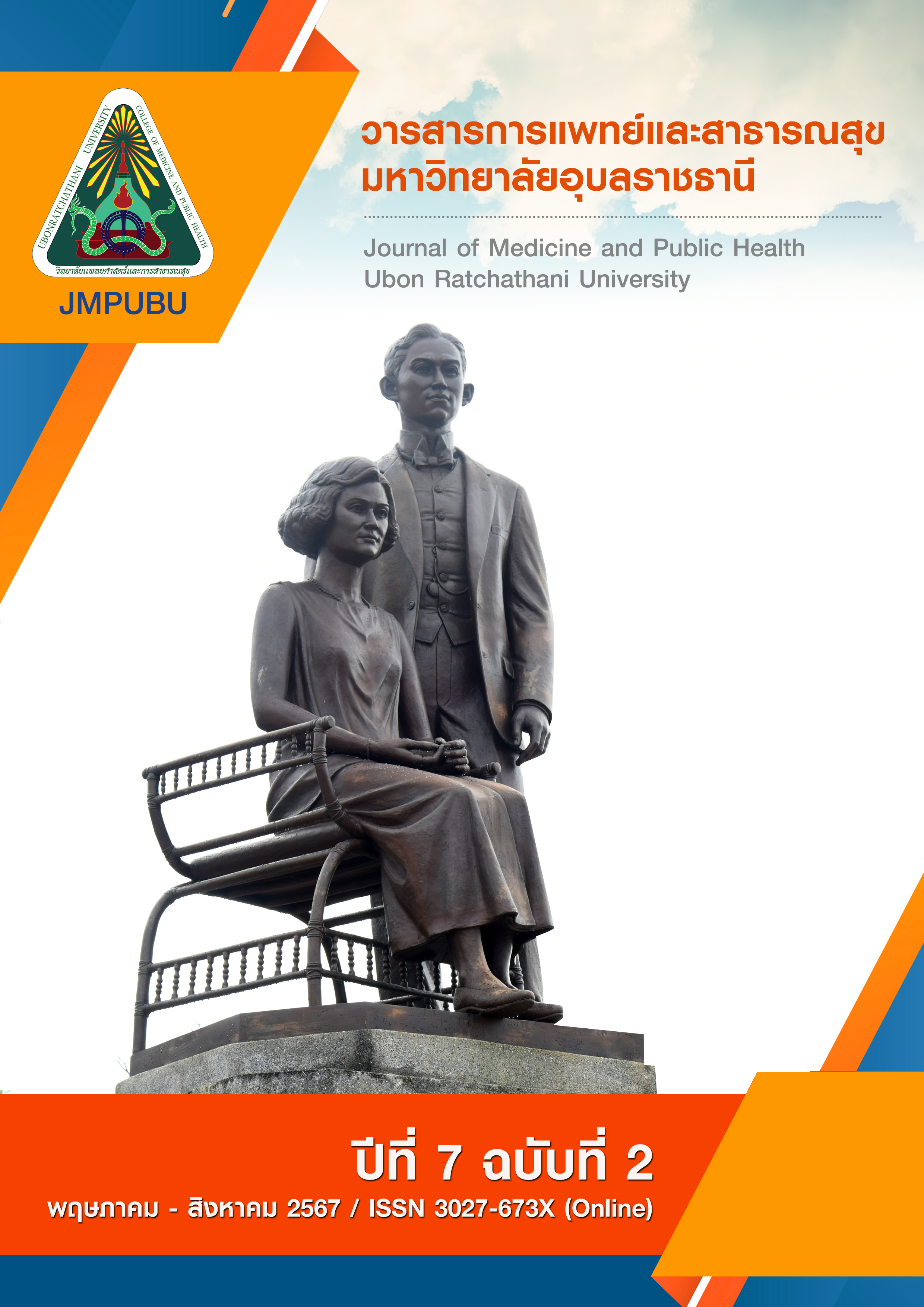การปลดปล่อยอนุภาคฝุ่นละอองจากรถกระบะเครื่องยนต์ดีเซลที่มีอายุการใช้งาน 10 ปี ภายใต้การจำลองการขับขี่ในห้องปฏิบัติการ
คำสำคัญ:
อนุภาคฝุ่นละออง, PM2.5, อนุภาคที่เกิดจากกระบะเครื่องยนต์ดีเซล, ปริมาณความเข้มข้นของอนุภาคฝุ่นละออง, การจำลองการขับขี่บทคัดย่อ
การศึกษาครั้งนี้มีวัตถุประสงค์เพื่อศึกษาการปลดปล่อยอนุภาคฝุ่นละออง (Particulate matter, PM) ที่เกิดจากการเผาไหม้ของรถกระบะเครื่องยนต์ดีเซลที่มีอายุการใช้งาน 10 ปี ภายใต้การจำลองการทดสอบการขับขี่สองสภาวะ ได้แก่ การขับขี่ในสภาวะในเมืองและสภาวะนอกเมือง ซึ่งสอดคล้องตามมาตรฐาน United Nation Regulation 83 (UN R83) การวิเคราะห์ความเข้มข้นของอนุภาคฝุ่นละอองที่เกิดขึ้นขณะขับขี่ถูกตรวจวัดโดยใช้เครื่อง Portable Aerosol Spectrometer Dust Detector (PAS) รุ่น GRIMM 11D ทำการตรวจวัด TSP, PM10, PM4, PM2.5, PM1, Inhalable dust, Thoracic dust และ Respirable dust ผลการศึกษาพบว่าการขับขี่ในสภาวะในเมืองและสภาวะนอกเมืองปลดปล่อยค่าเฉลี่ยของอนุภาคฝุ่นละอองสูงสุดคือฝุ่นประเภท TSP (46.72 µg/m³ และ 43.05 µg/m³ ตามลำดับ) และ Inhalable dust (46.25 µg/m³ และ 41.93 µg/m³ ตามลำดับ) โดยความเข้มข้นที่ถูกปลดปล่อยจากทั้งสองสภาวะมีแนวโน้มที่เพิ่มขึ้นตามความเร่งที่ใช้ในการขับขี่และจะลดลงเมื่อลดความเร็ว แต่อย่างไรก็ตามขั้นตอนลดความเร็วจาก 100-0 km/h ในสภาวะนอกเมืองพบว่าความเข้มข้นของ TSP, Inhalable dust และ Thoracic dust มีค่าเพิ่มขึ้น แม้ว่าผลการเปรียบเทียบความเข้มข้นของอนุภาคฝุ่นละอองระหว่างสองสภาวะไม่แตกต่างกันอย่างมีนัยสำคัญทางสถิติ แต่ลักษณะการขับขี่ที่มีการเร่งและชะลอความเร็วบ่อยครั้งส่งผลให้เครื่องยนต์ทำงานอย่างไม่มีประสิทธิภาพก่อให้เกิดการปลดปล่อยอนุภาคฝุ่นละอองที่สูงขึ้น ดังนั้นการปรับเปลี่ยนพฤติกรรมการขับขี่ที่ลดการเปลี่ยนแปลงความเร็วอย่างฉับพลันและการปรับปรุงระบบจราจร รวมถึงการวางแผนเส้นทางการจราจรให้มีประสิทธิภาพมีส่วนช่วยในการลดการปลดปล่อยอนุภาคฝุ่นละอองจากการขับขี่ยานพาหนะสู่บรรยากาศได้
Downloads
เอกสารอ้างอิง
Chuersuwan N, Nimrat S, Lekphet S, Kerdkumrai T. Levels and major sources of PM2.5 and PM10 in Bangkok Metropolitan Region. Environment international. 2008 Jul 1;34:671–7.
จุฬาลงกรณ์มหาวิทยาลัย. เรียนรู้อยู่กับฝุ่น PM2.5. [อินเทอร์เน็ต]. 2562. [สืบค้นเมื่อ 28 กุมภาพันธ์ 2566]. แหล่งข้อมูล: https://www.chula.ac.th/wp-content/uploads/2019/10/Chula-PM25.pdf
Raza M, Chen L, Leach F, Ding S. A Review of Particulate Number (PN) Emissions from Gasoline Direct Injection (GDI) Engines and Their Control Techniques. Energies. 2018 Jun 1;6.
American Lung Association. Health Impact of Pollution | State of the Air [Internet]. 2022 [cited 2023 Jan 18]. Available from: https://www.lung.org/research/sota/health-risks
Deng X, Feng N, Zheng M, Ye X, Lin H, Yu X, et al. PM2.5 exposure-induced autophagy is mediated by lncRNA loc146880 which also promotes the migration and invasion of lung cancer cells. Biochim Biophys Acta Gen Subj. 2017 Feb;1861(2):112–25.
IARC. IARC: DIESEL ENGINE EXHAUST CARCINOGENIC [Internet]. 2012 [cited 2023 Jan 26]. Available from: https://www.iarc.who.int/wp-content/uploads/2018/07/pr213_E.pdf
US EPA O. Health and Environmental Effects of Particulate Matter (PM) [Internet]. 2016 [cited 2023 Jan 17]. Available from: https://www.epa.gov/pm-pollution/health-and-environmental-effects-particulate-matter-pm
ชนกนันท์ ก. ปัจจัยที่มีอิทธิพลต่อการตัดสินใจซื้อรถกระบะดัดแปลง PPV ของผู้บริโภคในเขตกรุงเทพมหานคร. [อินเทอร์เน็ต] 21 มกราคม 2060 [สืบค้นเมื่อ 8 มีนาคม 2566]. แหล่งข้อมูล: https://ethesisarchive.library.tu.ac.th/thesis/2016/TU_2016_5807011167_6755_5210.pdf
Punyaroj S. พฤติกรรมของผู้บริโภคในการเลือกซื้อและใช้รถยนต์กระบะ ในกลุ่มจังหวัดภาคเหนือตอนล่าง. วารสารการวิจัยกาสะลองคำ มหาวิทยาลัยราชภัฏเชียงราย. 2017;11(3):305–15.
กรมการขนส่งทางบก. กลุ่มสถิติการขนส่ง กองแผนงาน กรมการขนส่งทางบก [อินเทอร์เน็ต]. 2565 [สืบค้นเมื่อ 21 มีนาคม 2566]. แหล่งข้อมูล https://web.dlt.go.th/statistics/
Supasri T, Gheewala S, Macatangay R, Chakpor A, Sedpho S. Association between ambient air particulate matter and human health impacts in northern Thailand. Scientific Reports. 2023 Aug 7;13.
Guttikunda SK, Mohan D. Re-fueling road transport for better air quality in India. Energy Policy. 2014 May 1;68:556–61.
Singh V, Biswal A, Kesarkar AP, Mor S, Ravindra K. High resolution vehicular PM10 emissions over megacity Delhi: Relative contributions of exhaust and non-exhaust sources. Science of The Total Environment. 2020 Jan 10;699:134273.
Weber C, Sundvor I, Figenbaum E. Comparison of regulated emission factors of Euro 6 LDV in Nordic temperatures and cold start conditions: Diesel- and gasoline direct-injection. Atmospheric Environment. 2019 Jun 1;206:208–17.
Yoann B, Tim D, Kaylin L, Isabel R, Uwe T. Evaluation of real-world vehicle emissions in Brussels. The Real Urban Emissions Initiative [Internet]. 2021 Nov [cited 2024 Mar 8]; Available from: https://www.trueinitiative.org/data/publications/evaluation-of-real-world-vehicle-emissions-in-brussels
Giechaskiel B. Solid Particle Number Emission Factors of Euro VI Heavy-Duty Vehicles on the Road and in the Laboratory. International Journal of Environmental Research and Public Health. 2018 Feb;15(2):304.
Jung S, Lim J, Kwon S, Jeon S, Kim J, Lee J, et al. Characterization of particulate matter from diesel passenger cars tested on chassis dynamometers. Journal of Environmental Sciences. 2017 Apr 1;54:21–32.
Peckham M, Finch A, Price P, Davies M. Study of Particle Number Emissions from a Turbocharged Gasoline Direct Injection (GDI) Engine Including Data from a Fast-Response Particle Size Spectrometer. SAE Technical Papers. 2011 Apr 12;
Bermúdez V, Luján JM, Ruiz S, Campos D, Linares WG. New European Driving Cycle assessment by means of particle size distributions in a light-duty diesel engine fuelled with different fuel formulations. Fuel. 2015 Jan 15;140:649–59.
Yang HH, Dhital NB, Wang LC, Hsieh YS, Lee KT, Hsu YT, et al. Chemical Characterization of Fine Particulate Matter in Gasoline and Diesel Vehicle Exhaust. Aerosol Air Qual Res. 2019;19(6):1349–449.
UN. UN R83 [Internet]. UNITED NATIONS; 2015 [cited 2023 Jan 27]. Available from: https://unece.org/fileadmin/DAM/trans/main/wp29/wp29regs/R083r5e.pdf
Jankowska E. Mass and Number Concentration and Size Distribution of Particles Emitted from Diesel Engine. IJTEE. 2010 Dec 15;3(2):109–12.
Kumar A, Srivastava D, Agrawal M, Goel A. Snapshot of PM Loads Evaluated at Major Road and Railway Intersections in an Urban Locality. International Journal of Environmental Protection. 2014;4.
ส่วนสถานตรวจสภาพรถสำนักวิศวกรรมยานยนต์กรมการขนส่งทางบก. คู่มือการปฏิบัติงานสำหรับสถานตรวจสภาพรถ [อินเทอร์เน็ต]. 2561 [สืบค้นเมื่อ 14 มกราคม 2565]. . แหล่งข้อมูล: http://www.sahavit.com/inspection/Downloads/การปฎิบัติงานสำหรับสถานตรวจสถาพรถ1.pdf
OSHA. OSHA Technical Manual (OTM) - Section II: Chapter 1 | Occupational Safety and Health Administration [Internet]. 2023 [cited 2024 Mar 23]. Available from: https://www.osha.gov/otm/section-2-health-hazards/chapter-1
Wang S, Zhu X, Somers LMT, de Goey LPH. Effects of exhaust gas recirculation at various loads on diesel engine performance and exhaust particle size distribution using four blends with a research octane number of 70 and diesel. Energy Conversion and Management. 2017 Oct 1;149:918–27.
Peckham M, Finch A. Analysis of Transient HC, CO, NOx and CO2 Emissions from a GDI Engine using Fast Response Gas Analyzers. SAE International Journal of Engines. 2011 Jun 15;4:1513–22.
Kim J, Choi K, Myung CL, Lee Y, Park S. Comparative investigation of regulated emissions and nano-particle characteristics of light duty vehicles using various fuels for the FTP-75 and the NEDC mode. Fuel. 2013 Apr 1;106:335–43.
Shen X, Shi Y, Kong L, Cao X, Li X, Wu B, et al. Particle number emissions from light-duty gasoline vehicles in Beijing, China. Science of The Total Environment. 2021 Jun 15;773:145663.
Yue DL, Hu M, Wang ZB, Wen MT, Guo S, Zhong LJ, et al. Comparison of particle number size distributions and new particle formation between the urban and rural sites in the PRD region, China. Atmospheric Environment. 2013 Sep 1;76:181–8.
ดาวน์โหลด
เผยแพร่แล้ว
รูปแบบการอ้างอิง
ฉบับ
ประเภทบทความ
สัญญาอนุญาต
ลิขสิทธิ์ (c) 2024 วารสารการแพทย์และสาธารณสุข มหาวิทยาลัยอุบลราชธานี

อนุญาตภายใต้เงื่อนไข Creative Commons Attribution-NonCommercial-NoDerivatives 4.0 International License.
เนื้อหาและข้อมูลในบทความที่ลงตีพิมพ์ในวารสารการแพทย์และสาธารณสุข มหาวิทยาลัยอุบลราชธานี ถือเป็นข้อคิดเห็นและความรับผิดชอบของผู้เขียนบทความโดยตรง ซึ่งกองบรรณาธิการวารสารไม่จำเป็นต้องเห็นด้วย หรือร่วมรับผิดชอบใด ๆ
บทความ ข้อมูล เนื้อหา รูปภาพ ฯลฯ ที่ได้รับการตีพิมพ์ในวารสารการแพทย์และสาธารณสุข มหาวิทยาลัยอุบลราชธานี ถือเป็นลิขสิทธิ์ของวารสารการแพทย์และสาธารณสุข มหาวิทยาลัยอุบลราชธานี กองบรรณาธิการไม่สงวนสิทธิ์ในการคัดลอกเพื่อการพัฒนางานด้านวิชาการ แต่ต้องได้รับการอ้างอิงที่ถูกต้องเหมาะสม






